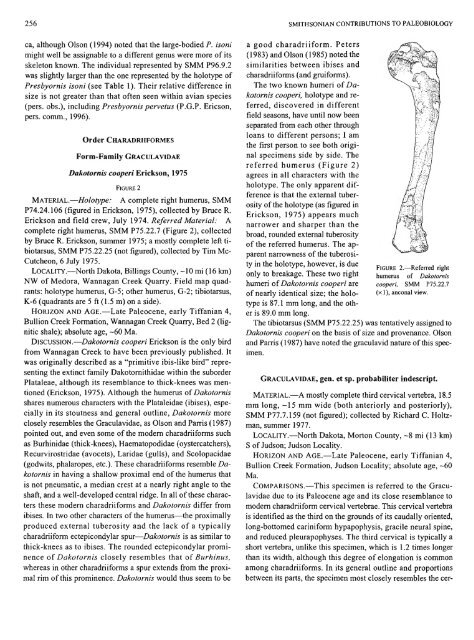PDF (Lo-Res) - Smithsonian Institution Libraries
PDF (Lo-Res) - Smithsonian Institution Libraries
PDF (Lo-Res) - Smithsonian Institution Libraries
Create successful ePaper yourself
Turn your PDF publications into a flip-book with our unique Google optimized e-Paper software.
256 SMITHSONIAN CONTRIBUTIONS TO PALEOBIOLOGY<br />
ca, although Olson (1994) noted that the large-bodied P. isoni<br />
might well be assignable to a different genus were more of its<br />
skeleton known. The individual represented by SMM P96.9.2<br />
was slightly larger than the one represented by the holotype of<br />
Presbyornis isoni (see Table 1). Their relative difference in<br />
size is not greater than that often seen within avian species<br />
(pers. obs.), including Presbyornis pervetus (P.G.P. Ericson,<br />
pers. comm., 1996).<br />
Order CHARADRIIFORMES<br />
Form-Family GRACULAVIDAE<br />
Dakotornis cooperi Erickson, 1975<br />
FIGURE 2<br />
MATERIAL.—Holotype: A complete right humems, SMM<br />
P74.24.106 (figured in Erickson, 1975), collected by Bmce R.<br />
Erickson and field crew, July 1974. Referred Material: A<br />
complete right humems, SMM P75.22.7 (Figure 2), collected<br />
by Bmce R. Erickson, summer 1975; a mostly complete left tibiotarsus,<br />
SMM P75.22.25 (not figured), collected by Tim Mc-<br />
Cutcheon, 6 July 1975.<br />
LOCALITY.—North Dakota, Billings County, -10 mi (16 km)<br />
NW of Medora, Wannagan Creek Quarry. Field map quadrants:<br />
holotype humems, G-5; other humems, G-2; tibiotarsus,<br />
K-6 (quadrants are 5 ft (1.5 m) on a side).<br />
HORIZON AND AGE.—Late Paleocene, early Tiffanian 4,<br />
Bullion Creek Formation, Wannagan Creek Quarry, Bed 2 (lignitic<br />
shale); absolute age, -60 Ma.<br />
DISCUSSION.—Dakotornis cooperi Erickson is the only bird<br />
from Wannagan Creek to have been previously published. It<br />
was originally described as a "primitive ibis-like bird" representing<br />
the extinct family Dakotomithidae within the suborder<br />
Plataleae, although its resemblance to thick-knees was mentioned<br />
(Erickson, 1975). Although the humems of Dakotornis<br />
shares numerous characters with the Plataleidae (ibises), especially<br />
in its stoutness and general outline, Dakotornis more<br />
closely resembles the Graculavidae, as Olson and Parris (1987)<br />
pointed out, and even some of the modem charadriiforms such<br />
as Burhinidae (thick-knees), Haematopodidae (oystercatchers),<br />
Recurvirostridae (avocets), Laridae (gulls), and Scolopacidae<br />
(godwits, phalaropes, etc.). These charadriiforms resemble Dakotornis<br />
in having a shallow proximal end of the humems that<br />
is not pneumatic, a median crest at a nearly right angle to the<br />
shaft, and a well-developed central ridge. In all of these characters<br />
these modem charadriiforms and Dakotornis differ from<br />
ibises. In two other characters of the humems—the proximally<br />
produced external tuberosity and the lack of a typically<br />
charadriiform ectepicondylar spur—Dakotornis is as similar to<br />
thick-knees as to ibises. The rounded ectepicondylar prominence<br />
of Dakotornis closely resembles that of Burhinus,<br />
whereas in other charadriiforms a spur extends from the proximal<br />
rim of this prominence. Dakotornis would thus seem to be<br />
a good charadriiform. Peters<br />
(1983) and Olson (1985) noted the<br />
similarities between ibises and<br />
charadriiforms (and gruiforms).<br />
The two known humeri of Dakotornis<br />
cooperi, holotype and referred,<br />
discovered in different<br />
field seasons, have until now been<br />
separated from each other through<br />
loans to different persons; I am<br />
the first person to see both original<br />
specimens side by side. The<br />
referred humerus (Figure 2)<br />
agrees in all characters with the<br />
holotype. The only apparent difference<br />
is that the external tuberosity<br />
of the holotype (as figured in<br />
Erickson, 1975) appears much<br />
narrower and sharper than the<br />
broad, rounded external tuberosity<br />
of the referred humems. The apparent<br />
narrowness of the tuberosity<br />
in the holotype, however, is due<br />
only to breakage. These two right<br />
humeri of Dakotornis cooperi are<br />
of nearly identical size; the holotype<br />
is 87.1 mm long, and the other<br />
is 89.0 mm long.<br />
-^»<br />
:'/;•• 4<br />
FIGURE 2.—Referred right<br />
humerus of Dakotornis<br />
cooperi, SMM P75.22.7<br />
(x 1), anconal view.<br />
The tibiotarsus (SMM P75.22.25) was tentatively assigned to<br />
Dakotornis cooperi on the basis of size and provenance. Olson<br />
and Parris (1987) have noted the graculavid nature of this spec-<br />
GRACULAVIDAE, gen. et sp. probabiliter indescript.<br />
MATERIAL.—A mostly complete third cervical vertebra, 18.5<br />
mm long, -15 mm wide (both anteriorly and posteriorly),<br />
SMM P77.7.159 (not figured); collected by Richard C. Holtzman,<br />
summer 1977.<br />
LOCALITY.—North Dakota, Morton County, -8 mi (13 km)<br />
S of Judson; Judson <strong>Lo</strong>cality.<br />
HORIZON AND AGE.—Late Paleocene, early Tiffanian 4,<br />
Bullion Creek Formation, Judson <strong>Lo</strong>cality; absolute age, -60<br />
Ma.<br />
COMPARISONS.—This specimen is referred to the Graculavidae<br />
due to its Paleocene age and its close resemblance to<br />
modem charadriiform cervical vertebrae. This cervical vertebra<br />
is identified as the third on the grounds of its caudally oriented,<br />
long-bottomed cariniform hypapophysis, gracile neural spine,<br />
and reduced pleurapophyses. The third cervical is typically a<br />
short vertebra, unlike this specimen, which is 1.2 times longer<br />
than its width, although this degree of elongation is common<br />
among charadriiforms. In its general outline and proportions<br />
between its parts, the specimen most closely resembles the cer-

















